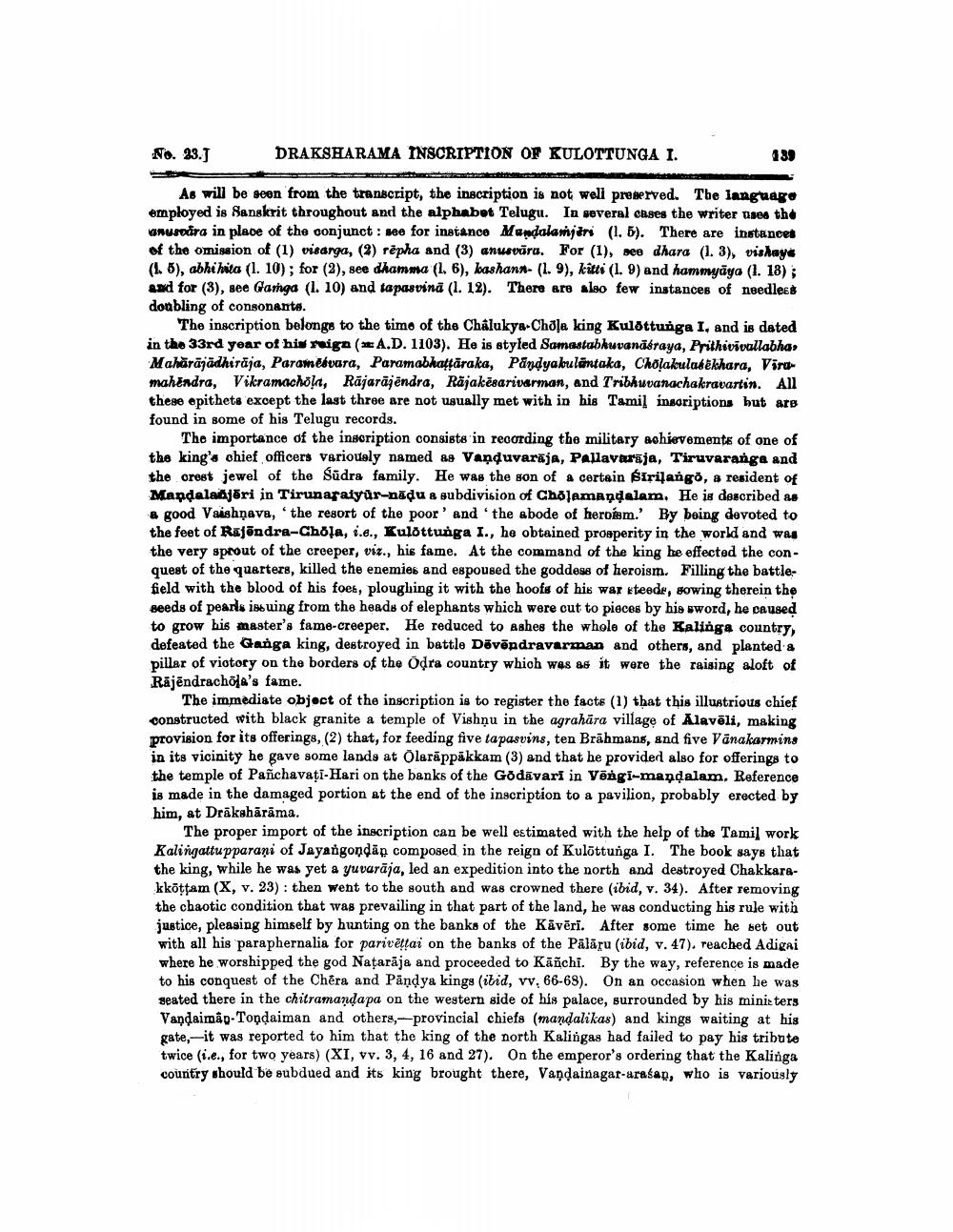________________
No. 23.J
DRAKSHARAMA INSCRIPTION OF KULOTTUNGA I.
As will be seen from the transcript, the inscription is not well preserved. The language employed is Sanskrit throughout and the alphabet Telugu. In several cases the writer uses the anuseara in place of the conjunct: see for instance Mandalamjeri (1.5). There are instances of the omission of (1) visarga, (2) rèpha and (3) anusvära. For (1), see dhara (1. 3), vishaya (1.5), abhi hita (1. 10); for (2), see dhamma (1, 6), kashann- (1. 9), kitti (1. 9) and hammyāya (1. 18); and for (3), see Gamga (1. 10) and tapasvina (1. 12). There are also few instances of needless doubling of consonants.
439
The inscription belongs to the time of the Chalukya-Chola king Kulottunga I, and is dated in the 33rd year of his reign (A.D. 1103). He is styled Samastabhuvanäsraya, Prithivivallabha, Maharajadhiraja, Paraméévara, Paramabhattaraka, Pandyakulantaka, Cholakulasekhara, Viramahendra, Vikramachōla, Rājarājëndra, Rajakesarivarman, and Tribhuvanachakravartin. All these epithets except the last three are not usually met with in his Tamil inscriptions but are found in some of his Telugu records.
The importance of the inscription consists in recording the military achievements of one of the king's chief officers variously named as Vaṇḍuvarāja, Pallavarāja, Tiruvaranga and the crest jewel of the Sudra family. He was the son of a certain Éirilango, a resident of Mandalañjöri in Tirunaraiyur-nadu a subdivision of Chōlamandalam. He is described as a good Vaishnava, the resort of the poor' and 'the abode of heroism.' By being devoted to the feet of Rajendra-Chōla, i.e., Kulottunga I., he obtained prosperity in the world and was the very sprout of the creeper, viz., his fame. At the command of the king he effected the conquest of the quarters, killed the enemies and espoused the goddess of heroism. Filling the battlefield with the blood of his foes, ploughing it with the hoofs of his war steeds, sowing therein the seeds of pearls issuing from the heads of elephants which were cut to pieces by his sword, he caused to grow his master's fame-creeper. He reduced to ashes the whole of the Kalinga country, defeated the Ganga king, destroyed in battle Devendravarman and others, and planted a pillar of victory on the borders of the Odra country which was as it were the raising aloft of Rajendrachōla's fame.
The immediate object of the inscription is to register the facts (1) that this illustrious chief constructed with black granite a temple of Vishnu in the agrahāra village of Alavēli, making provision for its offerings, (2) that, for feeding five tapasvins, ten Brahmans, and five Vanakarmins in its vicinity he gave some lands at Ōlarappakkam (3) and that he provided also for offerings to the temple of Panchavati-Hari on the banks of the Godavari in Vēngi-mandalam. Reference is made in the damaged portion at the end of the inscription to a pavilion, probably erected by him, at Draksharama.
The proper import of the inscription can be well estimated with the help of the Tamil work Kalingattupparani of Jayangondan composed in the reign of Kulottunga I. The book says that the king, while he was yet a yuvaraja, led an expedition into the north and destroyed Chakkarakkōṭṭam (X, v. 23): then went to the south and was crowned there (ibid, v. 34). After removing the chaotic condition that was prevailing in that part of the land, he was conducting his rule with justice, pleasing himself by hunting on the banks of the Kāvēri. After some time he set out with all his paraphernalia for pariveṭṭai on the banks of the Pālāru (ibid, v. 47). reached Adigai where he worshipped the god Nataraja and proceeded to Kanchi. By the way, reference is made to his conquest of the Chera and Pandya kings (ibid, vv, 66-68). On an occasion when he was seated there in the chitramandapa on the western side of his palace, surrounded by his ministers Vandaiman-Tonḍaiman and others,-provincial chiefs (mandalikas) and kings waiting at his gate, it was reported to him that the king of the north Kalingas had failed to pay his tribute twice (i.e., for two years) (XI, vv. 3, 4, 16 and 27). On the emperor's ordering that the Kalinga country should be subdued and its king brought there, Vandainagar-arasan, who is variously




